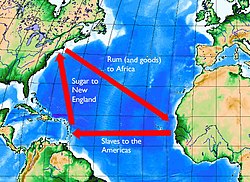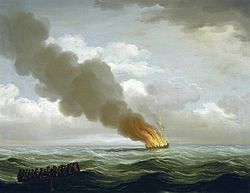Triangular trade
The triangular trade refers to trade between three ports or regions. Triangular trade usually develops when a region is exporting resources that are not needed in the region from which its main imports come. Instead, the resources are exported to a third region. The routes involved were historically also shaped by the winds and currents during the age of sailing ships.
The best-known triangular trading systems were across the Atlantic Ocean, especially the Atlantic slave trade, which lasted from the late 16th to early 19th centuries. During this time, European countries such as Great Britain, Spain, Portugal, the Netherlands and France had colonies in the Americas and Africa. The ships carrying slaves, crops and manufactured goods between West Africa, the Caribbean and American colonies and the colonial powers in Europe. The use of African slaves was very important to growing colonial cash crops, which were exported to Europe. European goods, in turn, were used to buy African slaves, which were then brought from West Africa to the Americas to work on the crops. The middle passage of the triangular trade refers to the transportation of the slaves to America.
The Atlantic economy was tied into the idea of mercantilism, which thought it was a good idea for European countries to have a lot of colonies that traded only with them. Goods that were traded in the Atlantic economy were rum, slaves, sugar, tobacco, gold, spices, fish, lumber and manufactured goods. Triangular trading became less common in the 20th century due to free trade and ships specialized for particular cargoes.
Triangular Trade Media
The loss of the slave ship Luxborough Galley in 1727 ("I.C. 1760"), lost in the last leg of the triangular trade, between the Caribbean and Britain.
Other websites
| Wikimedia Commons has media related to Lua error in Module:Commons_link at line 62: attempt to index field 'wikibase' (a nil value).. |
- The Transatlantic Slave Trade Database, a portal to data concerning the history of the triangular trade of transatlantic slave trade voyages





